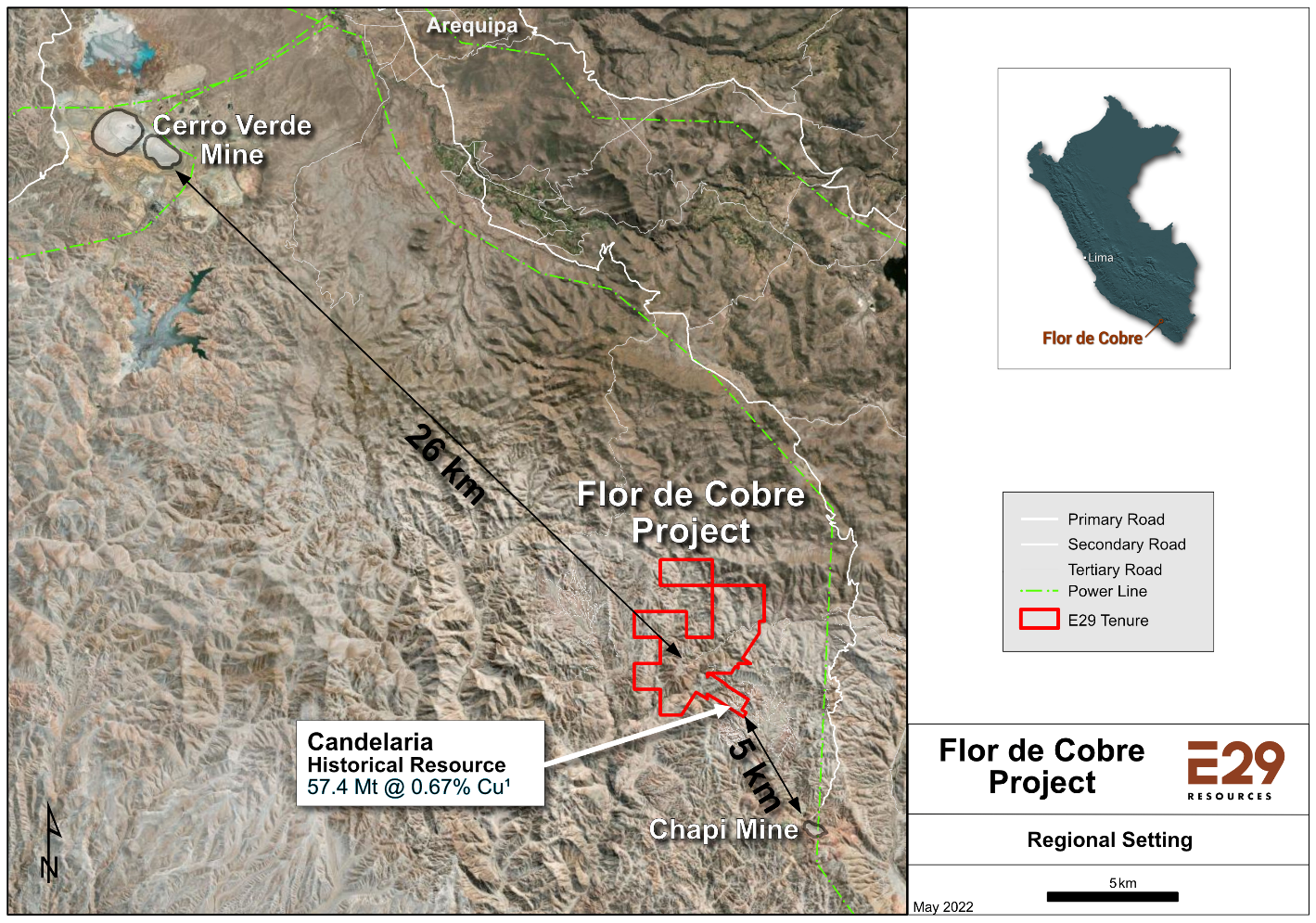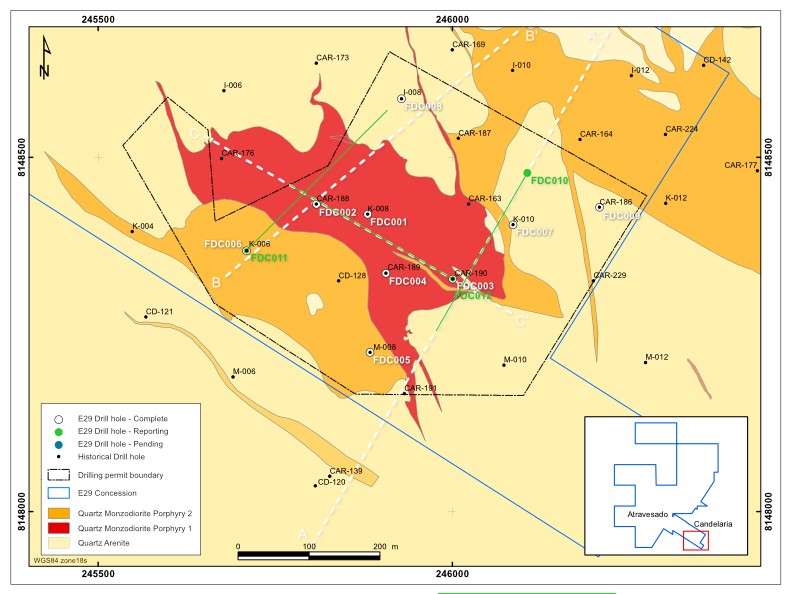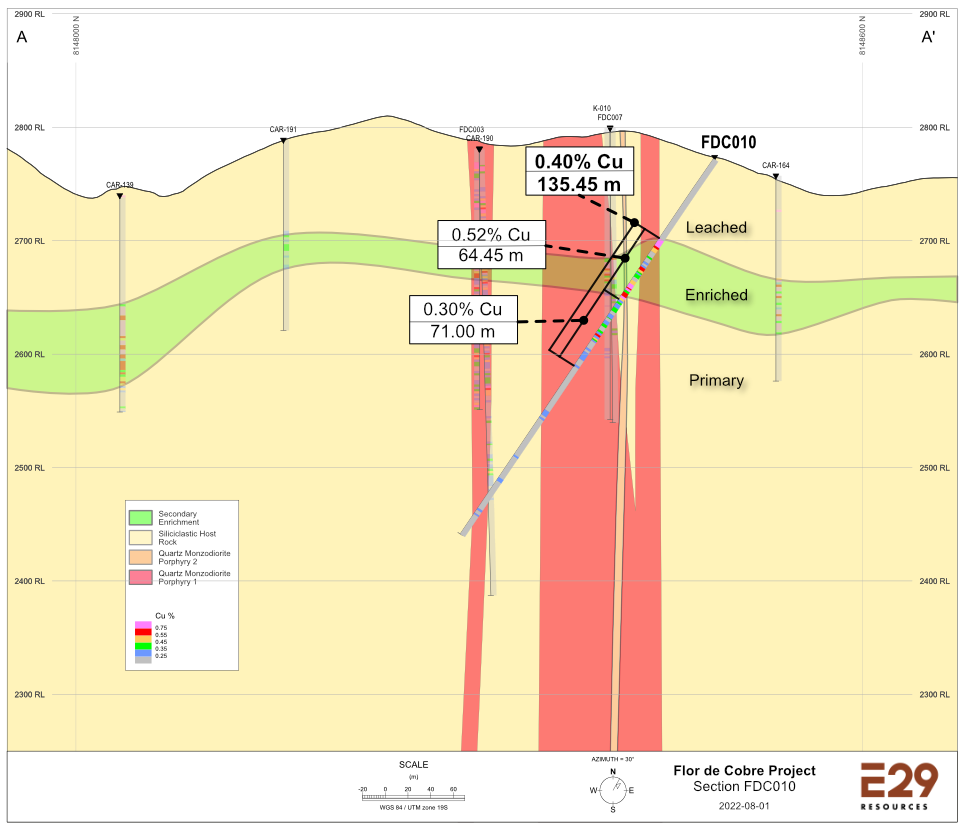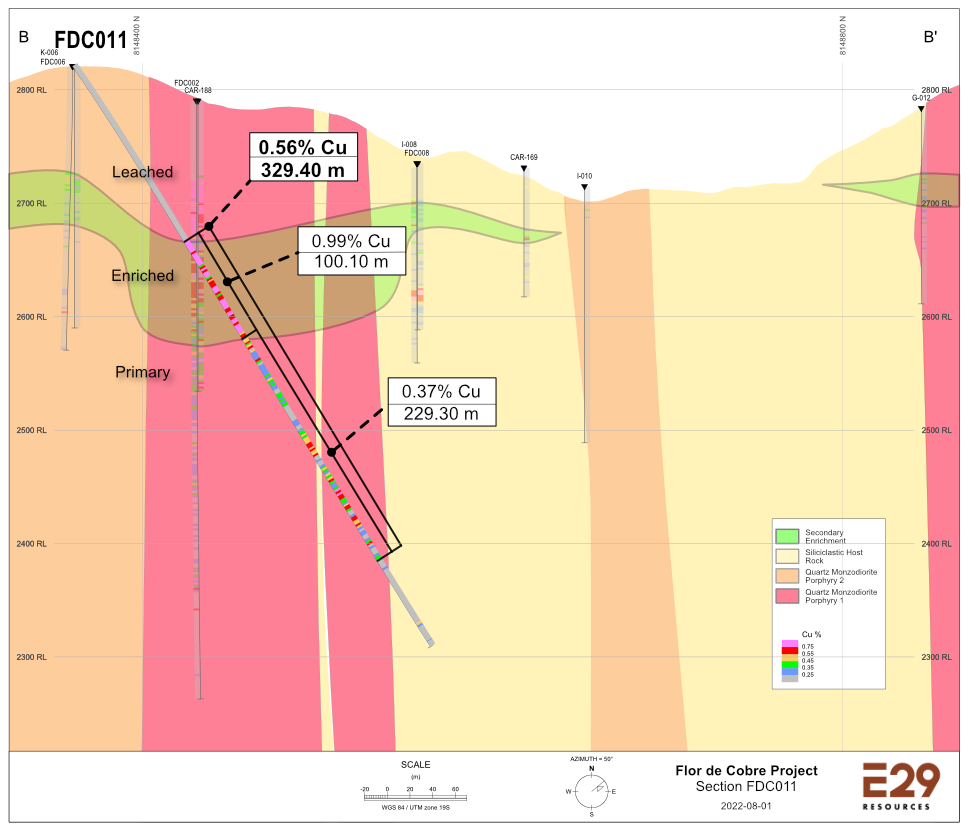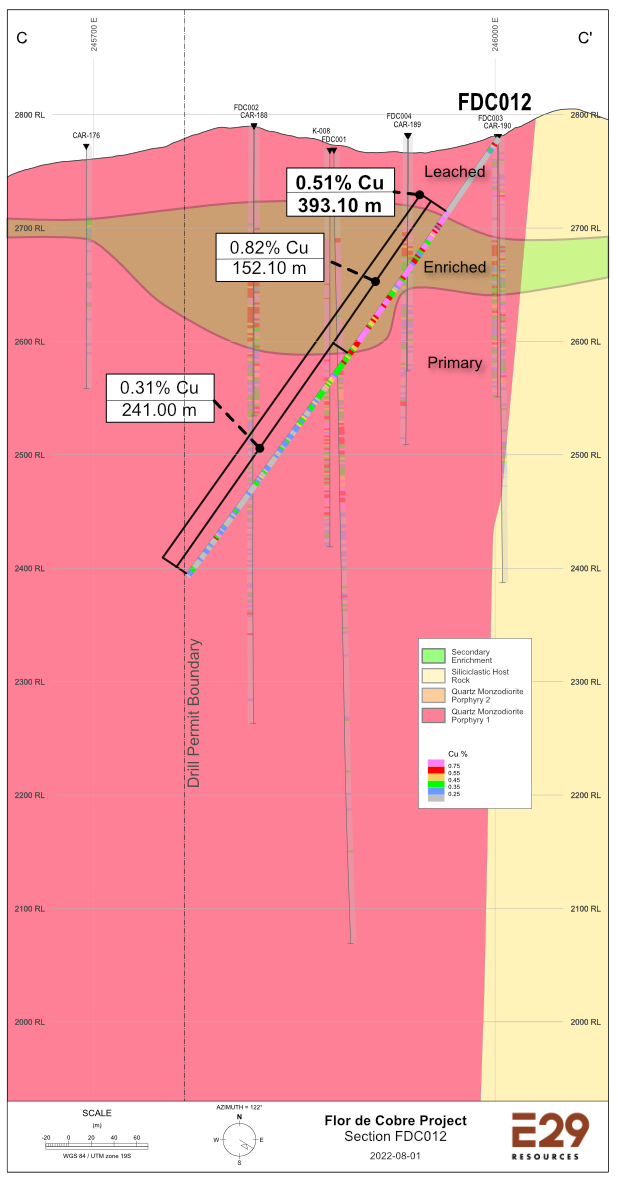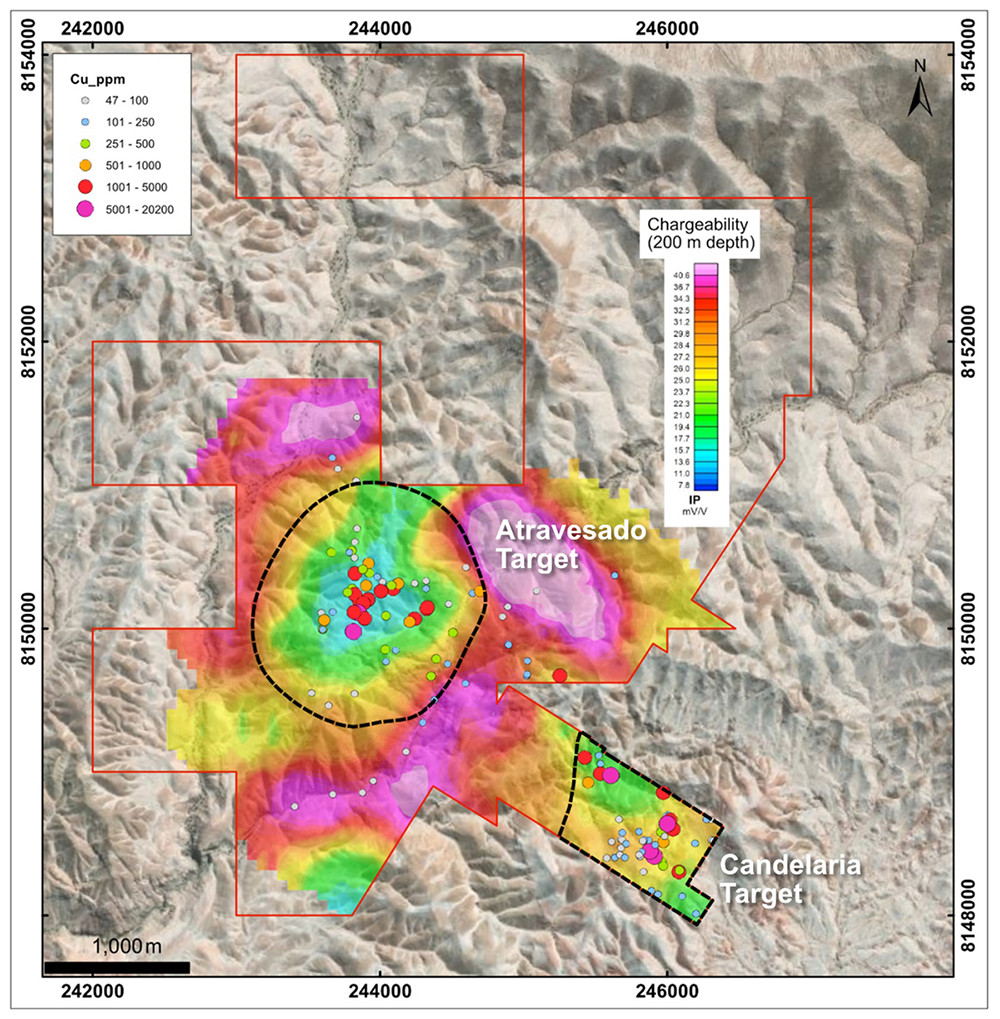Element 29 Releases Final Results from Flor de Cobre Drill Program Including 329.4 Metres of 0.56% Cu in Hole FDC011
Vancouver, Canada, September 7, 2022 – Element 29 Resources Inc. (“Element 29” or the “Company”) (TSX-V: ECU | OTCQB: EMTRF) announces results of the final three holes from the recently completed 4,532 metre (“m”), twelve-hole drill program at the Flor de Cobre Copper Project (“Flor de Cobre” or “the Project”) located in southern Peru (Figure 1).
Flor de Cobre Drilling Highlights
- Drillhole FDC011, located along the northwest margin of the permitted drilling area intersected 329.4 m of 0.56% copper (“Cu”) from 183.1 m, including 100.1 m of 0.99% Cu of enriched mineralization.
- Drillhole FDC012 intersected 393.1 m of 0.51% Cu, 0.005% Mo, 1.5 g/t Ag from 79.9 m including 152.1 m of 0.82% Cu of enriched mineralization.
- These angled drillholes add confidence to the position and geometry of the Candelaria Porphyry Complex (“Candelaria”) and presence of elevated copper grades within the primary sulphide mineralization.
- The Candelaria Porphyry Complex is untested to the northwest, toward the large Atravesado porphyry target (“Atravesado”) area.
Steve Stakiw, Element 29’s President and CEO comments, “These final drill results from our Flor de Cobre program have further boosted confidence in geological interpretations and distribution of the Candelaria Porphyry Complex, which is important for controlling copper mineralization. This understanding will be important for our next step of undertaking a mineral resource estimate incorporating all available data from the Candelaria portion of the Flor de Cobre project.”
Click HERE to watch a short video by Steve Stakiw, CEO, and Paul Johnston, Vice-President, Exploration, discussing the highlights of today’s press release.
The Company has successfully completed the objectives of this latest drill program, namely confirming the reliability of historical drillholes completed by Rio Amarillo Mining and Phelps Dodge in 1994 and 1995, and to explore for primary copper sulphide mineralization underneath the enrichment blanket to depths of over 500 m on the Candelaria portion of the Flor de Cobre property. Nine historical drillholes were selected for twinning based on cumulative grade times thickness and representing approximately 70% of the total cumulative grade-thickness intersected on the property. This will allow Element 29 to use the historical information as part of a drill hole dataset for the estimation of mineral resources that meets the CIM best practice guidelines (refer to July 6, 2022 press release).
Table 1. Results of drillholes FDC010, FDC011, and FDC012. Grades are length-weighted averages of samples within the intervals shown. A complete tabulation of reported drillhole mineralized intervals is given in Table 3.
| Hole | From (m) |
To (m) |
Length2 (m) |
Cu (%) |
Mo (%) |
Ag (ppm) |
As (ppm) |
CuEq1 (%) |
| FDC010 | 86.55 | 222.00 | 135.45 | 0.40 | 0.008 | 0.7 | 32 | 0.44 |
| enriched | 86.55 | 151.00 | 64.45 | 0.52 | 0.011 | 0.6 | 31 | 0.56 |
| primary | 151.00 | 222.00 | 71.00 | 0.30 | 0.005 | 0.8 | 33 | 0.33 |
| FDC011 | 183.10 | 512.50 | 329.40 | 0.56 | 0.008 | 1.4 | 231 | 0.60 |
| enriched | 183.10 | 283.20 | 100.10 | 0.99 | 0.005 | 1.4 | 111 | 1.02 |
| primary | 283.20 | 512.50 | 229.30 | 0.37 | 0.010 | 1.4 | 283 | 0.42 |
| including | 379.50 | 479.10 | 99.60 | 0.46 | 0.005 | 1.5 | 122 | 0.49 |
| includes | 382.90 | 405.30 | 22.40 | 0.54 | 0.005 | 1.7 | 187 | 0.57 |
| FDC012 | 79.90 | 473.00 | 393.10 | 0.51 | 0.005 | 1.1 | 18 | 0.53 |
| oxide | 6.40 | 16.40 | 10.00 | 0.33 | 0.005 | 1.6 | 21 | 0.36 |
| enriched | 79.90 | 232.00 | 152.10 | 0.82 | 0.005 | 0.9 | 17 | 0.85 |
| primary | 232.00 | 473.00 | 241.00 | 0.31 | 0.005 | 1.2 | 18 | 0.34 |
1 Copper equivalent grades (CuEq) are for comparative purposes only. Calculations are uncut and recovery is assumed to be 100% as metallurgical data is insufficient to allow for estimation of metal recoveries. Copper equivalence (CuEq %) is calculated as: CuEq (%) = Cu (%) + [3.55 × Mo (%)] + [0.0095 × Ag (g/t)], utilizing metal prices of Cu - US$3.34/lb, Mo - US$11.86/lb and Ag - US$21.87/oz. Metal prices are based on a 2-year average of monthly LME metal prices.
2 Intervals are downhole drilled core lengths. Drilling data to date is insufficient to determine true width of mineralization. Assay values are uncut.
The Company’s drill program consisted of 4,532 m of diamond drilling centred on the Candelaria Porphyry Complex (Figure 2). A total of 3,055 m was allocated to twin nine historical drillholes to verify the accuracy of existing historical geochemical assays and drill logs (Table 2). The first nine drillholes of the 2022 Flor de Cobre drill program included 349 m of 0.77% Cu, including 123 m of 1.42% Cu (refer to April 19, 2022 and June 1, 2022 press releases). The remaining 1,477 m in three drillholes noted in this news release was allocated to test the primary copper sulphide mineralization potential below the supergene enrichment blanket to depths of more than 500 m.
Table 2: List of twelve drillholes forming the 2022 Flor de Cobre drilling program. Nine of the twelve drillholes are designed to twin historical drillholes. The coordinates, depth, orientation, and hole type of the historical holes are shown. All results from the 2022 drilling program have been released.
| Hole ID | Hole ID (historical) |
East | North | Elev (m) |
Length (m) |
Azimuth (degrees) |
Dip (degrees) |
Historical Hole Type |
| FDC001 | K-008 | 245889.0 | 8148406.9 | 2769.0 | 700.2 | 0 | -90 | DDH |
| FDC002 | CAR-188 | 245811.7 | 8148415.9 | 2790.4 | 527.5 | 0 | -90 | RC |
| FDC003 | CAR-190 | 246002.4 | 8148314.2 | 2781.1 | 394.0 | 0 | -90 | RC |
| FDC004 | CAR-189 | 245911.9 | 8148319.3 | 2782.0 | 272.8 | 0 | -90 | RC |
| FDC005 | M-008 | 245892.9 | 8148214.7 | 2777.2 | 225.3 | 0 | -90 | DDH |
| FDC006 | K-006 | 245718.7 | 8148357.5 | 2820.6 | 250.2 | 0 | -90 | DDH |
| FDC007 | K-010 | 246091.4 | 8148395.9 | 2799.5 | 260.0 | 0 | -90 | DDH |
| FDC008 | I-008 | 245934.1 | 8148572.2 | 2735.2 | 176.0 | 0 | -90 | DDH |
| FDC009 | CAR-186 | 246212.0 | 8148416.6 | 2755.8 | 249.0 | 0 | -90 | RC |
| FDC010 | NA | 246121.2 | 8148485.2 | 2773.7 | 400.9 | 210 | -55 | NA |
| FDC011 | NA | 245716.6 | 8148359.5 | 2820.8 | 601.3 | 44 | -55 | NA |
| FDC012 | NA | 245999.6 | 8148312.7 | 2781.1 | 475.0 | 300 | -55 | NA |
Coordinates are in WGS84 zone 18S UTM
All drillholes intersected a sub-horizontal, secondary copper sulphide enrichment zone dominated by chalcocite located at the base of strongly leached porphyry and siliciclastic host rocks. Enriched copper oxides represent a minor component of the enrichment zone and where present, are situated above the secondary copper sulphide enrichment zone. The best mineralization is centred on the Candelaria Porphyry Complex, which is characterized by strong potassium silicate alteration (potassic) associated with chalcopyrite mineralization overprinted by quartz-sericite-pyrite (phyllic) alteration. Sections containing the drillholes are shown in Figures 3 – 5.
Implication of Results
All historical drillholes on the Flor de Cobre property were drilled vertically to test a sub-horizontal mineralized body. This made it difficult to interpret the orientation and position of porphyry contacts within the Candelaria Porphyry Complex. The last three drillholes were to remedy this while obtaining intersections of primary sulphide mineralization to depths up to 500 metres beneath the enrichment mineralization. These drillholes encountered broad zones of chalcopyrite mineralization with local intervals grading above 0.45% Cu. Furthermore, the northwest continuation of the Candelaria Porphyry Complex was demonstrated which remains untested at depth between Candelaria and Atravesado. The angled holes also support the continuity of supergene enrichment mineralization between vertical holes. This adds confidence to the geological interpretation and will improve resource estimation, which will be undertaken in the latter half of 2022.
The Company continues to progress drill permitting on Atravesado in preparation for initial drill-testing of a priority porphyry target supported by coincident outcrop geology, surface geochemistry, and geophysical responses. Atravesado is located approximately two kilometres (“km”) northwest of Candelaria and is a 1.5 km x 1.6 km circular zone characterized by outcropping copper oxide mineralization in association with quartz vein stockworks and potassic alteration (Figure 6). Late-mineral porphyry dikes are also mapped within the target area.
Analytical Quality Control & Quality Assurance
Candelaria Resources S.A.C., a wholly owned subsidiary of Element 29 Resources Inc., supervises drilling and carries out sampling of HQ and NQ core. Logging and sampling are completed at a secured Company facility situated on the Flor de Cobre project site. Sample intervals are nominally 2 m long. Drill core is cut in half using a rotary diamond blade saw and samples are sealed on site before transportation to the ALS Peru S.A.C. sample preparation facility in Arequipa by Company vehicles and staff. Prepared samples are sent to Lima by ALS Peru S.A.C. for analysis. ALS Peru S.A.C. is an independent laboratory. Samples are analyzed for 35 elements using an Aqua Regia digestion and ICP-AES analysis (ME-ICP41). Samples reporting over limits are analyzed by Aqua Regia digestion with ICP-AES finish (ME-OG46). ALS meets all requirements of International Standards ISO/IEC 17025:2005 and ISO 9001:2015 for analytical procedures.
Element 29 employs an independent, internal quality assurance/quality control program that includes insertion of duplicate, blank, and certified reference samples at the field site. The Company is not aware of any drilling, sampling, recovery, or other factors that could materially affect the accuracy or reliability of the data reported.
Qualified Person
The scientific and technical content of this press release has been reviewed and approved by Paul J. Johnston (PhD, P.Geo), Vice President of Exploration for Element 29 and is a “Qualified Person” as defined in National Instrument 43-101 Standards of Disclosure for Mineral Projects.
Neither the TSX Venture Exchange nor its Regulation Service Provider (as that term is defined in the policies of the TSX Venture Exchange) accepts responsibility for the adequacy or accuracy of this press release.
About Flor de Cobre
Flor de Cobre is a porphyry copper exploration project that contains the Candelaria Porphyry Complex and the recently outlined Atravesado porphyry copper target. The property is in the Southern Peru Copper Belt and is five km northwest of Nexa Resources’ Chapi mine and 26 km southeast of the Cerro Verde mine owned by Freeport-McMoRan, Sumitomo Metal Mining, and Compañía de Minas Buenaventura. Candelaria is a classic Andean porphyry system with primary copper sulphide mineralization associated with a multi-phase quartz monzonite porphyry complex. Weathering redistributed primary mineralization into a sub-horizontal enrichment blanket containing secondary copper oxide and sulphide minerals at the base of a hematitic leached cap. Remnants of the upper jarositic component of the leached cap overlying the hematitic cap are preserved on the higher hill tops around the Candelaria prospect. Atravesado is a porphyry copper exploration target located about two km northwest of Candelaria. An IP/Resistivity geophysical survey completed in 2020 outlined a core of moderate resistivity measuring 1.5 x 1.6 km that coincides with widespread copper oxide mineralization, strong copper geochemistry, and late-stage quartz monzodiorite porphyry dikes. The resistive core is surrounded by a high-chargeability halo corresponding with weathered quartz-sericite-pyrite alteration.
About Element 29 Resources Inc.
Element 29 Resources Inc. is an emerging copper exploration and development company focused on advancing its portfolio of Peruvian projects towards development in one of the world’s lower-risk mining jurisdictions. Element 29’s growth strategy is led by our strong board and management, who have a proven track record of discovery and delivering significant value to our shareholders.
The Company’s principal objective is to explore and develop its flagship Flor de Cobre porphyry Cu-Mo project located in southern Peru, 26 km southeast from Freeport-McMoRan’s Cerro Verde Cu-Mo mine. At the same time, the Company intends to build on its potential copper inventory with continued exploration of its Flor de Cobre project as well as its remaining 22,000 hectares of mining concessions in Peru, including the recently discovered Elida porphyry copper-molybdenum-silver system located 85 km from the coast in central Peru. Both projects are well located for potential mine development and will benefit from nearby infrastructure including roads, powerlines, ports, water, and a skilled workforce.
More information is available at www.e29copper.com.
For more information:
Steve Stakiw, President & CEO
1-888-246-7881
[email protected]
Forward Looking Statements
This press release contains certain forward-looking information and forward-looking statements within the meaning of applicable Canadian securities legislation (collectively, “Forward-looking Statements”). All statements, other than statements of historical fact, constitute Forward-looking Statements. Words such as “will”, “intends”, “proposed” and “expects” or similar expressions are intended to identify Forward-looking Statements. Forward looking Statements in this press release include statements related the Company’s resource properties, and the Company’s plans, focus and objectives.
Forward-looking Statements involve various risks and uncertainties and are based on certain factors and assumptions. There can be no assurance that such statements will prove to be accurate, and actual results and future events could differ materially from those anticipated in such statements. Important factors that could cause actual results to differ materially from the Company's expectations include uncertainties related to fluctuations in copper and other commodity prices, uncertainties inherent in the exploration of mineral properties, the impact and progression of the COVID-19 pandemic and other risk factors set forth in the Company’s prospectus under the heading “Risk Factors”. The Company undertakes no obligation to update or revise any Forward-looking Statements, whether as a result of new information, future events or otherwise, except as may be required by law. New factors emerge from time to time, and it is not possible for Element 29 to predict all of them or assess the impact of each such factor or the extent to which any factor, or combination of factors, may cause results to differ materially from those contained in any Forward-looking Statement. Any Forward-looking Statements contained in this press release are expressly qualified in their entirety by this cautionary statement.
Figure 1. Regional setting of the Flor de Cobre Project is in the Southern Peru Copper Belt, between the Cerro Verde and Chapi mines. The project is at a moderate elevation of less than 2,700 m, is road accessible, and is close to excellent infrastructure for mine development and operation.
1 The source of the historical resource estimate is the report Rio Amarillo Mining Ltd. – Candelaria Porphyry Copper Deposit, Arequipa, Peru, Mineral Reserve Estimate, 1996. This historical resource is relevant to Flor de Cobre as it suggests supergene-enriched mineralization of interest may be present at Candelaria. However, the Company cautions that the parameters, assumptions, and methods used to calculate the historical estimate are unknown. Additionally, the historical estimate does not use resource categories described in CIM Definition Standards for Mineral Resources and Mineral Reserves (2014). It is also unclear what portion of this historical resource estimate is within the current Flor de Cobre property configuration. A Qualified Person has not done sufficient work to classify the historical estimate as a current mineral resource, and it is unclear what work might be required to confirm the resource. For these reasons, the historical resource has not been verified by the Company and the Company is not treating the historical estimate as a current mineral resource.
Figure 2. Simplified geology map of the southeastern end of the Flor de Cobre concessions illustrating the Candelaria Porphyry Complex. Drill hole locations of the 2022 drill program and historical drillholes are shown. The positions of sections containing holes FDC010, FDC011, and FDC012 are indicated with white dashed lines.
Figure 3. Section A-A' showing the position of FDC010, which was inclined to determine the nature of the southeast end of the Candelaria Porphyry Complex.
Figure 4. Section B-B’ showing the position of FDC011 relative to the quartz monzodiorite porphyry. The hole was angled to provide information on the geometry of the porphyry intrusions.
Figure 5. Section C-C’ showing the position of FDC012 drilled northwest to test for continuity of enrichment superimposed on the porphyry stock. The hole was drilled to the drilling permit boundary.
Figure 6. The Atravesado porphyry target is characterized by moderate resistivity, anomalous copper geochemistry, potassic alteration and associated quartz vein stockworks. Phyllic alteration correlates with zones of high chargeability. The Candelaria Porphyry Complex is located 2.0 km to the southeast.
Table 3. Results from all drillholes completed in the 2022 drilling campaign. Grades are length-weighted averages of samples within the intervals shown.
| Hole | From (m) |
To (m) |
Length2 (m) |
Cu (%) |
Mo (%) |
Ag (ppm) |
As (ppm) |
CuEq1 (%) |
| FDC001 | 78.00 | 427.00 | 349.00 | 0.77 | 0.006 | 1.7 | 86 | 0.81 |
| enriched | 78.00 | 201.00 | 123.00 | 1.42 | 0.004 | 1.8 | 104 | 1.45 |
| primary | 201.00 | 427.00 | 226.00 | 0.42 | 0.007 | 1.7 | 75 | 0.46 |
| including | 201.00 | 318.10 | 117.10 | 0.58 | 0.007 | 2.0 | 90 | 0.62 |
| includes | 239.00 | 269.50 | 30.50 | 0.65 | 0.008 | 2.4 | 119 | 0.70 |
| includes | 287.50 | 318.10 | 30.60 | 0.73 | 0.005 | 3.2 | 108 | 0.78 |
| including | 318.10 | 427.00 | 108.90 | 0.25 | 0.006 | 1.2 | 60 | 0.28 |
| FDC002 | 70.95 | 449.50 | 378.55 | 0.50 | 0.006 | 1.3 | 24 | 0.54 |
| enriched | 70.95 | 201.65 | 130.70 | 0.90 | 0.006 | 1.1 | 44 | 0.93 |
| primary | 201.65 | 449.50 | 247.85 | 0.30 | 0.006 | 1.3 | 13 | 0.33 |
| including | 201.65 | 357.90 | 156.25 | 0.32 | 0.004 | 1.1 | 10 | 0.35 |
| including | 357.90 | 449.50 | 91.60 | 0.26 | 0.004 | 1.7 | 18 | 0.29 |
| FDC003 | 14.35 | 310.00 | 295.65 | 0.38 | 0.009 | 1.1 | 111 | 0.42 |
| oxide | 14.35 | 61.30 | 46.95 | 0.69 | 0.005 | 0.7 | 16 | 0.72 |
| enriched | 97.20 | 164.50 | 67.30 | 0.46 | 0.018 | 0.6 | 31 | 0.53 |
| primary | 164.50 | 310.00 | 145.50 | 0.30 | 0.005 | 1.3 | 197 | 0.33 |
| FDC004 | 74.40 | 239.00 | 164.60 | 0.43 | 0.006 | 0.7 | 12 | 0.46 |
| enriched | 74.40 | 111.85 | 37.45 | 0.75 | 0.003 | 0.8 | 19 | 0.77 |
| primary | 111.85 | 239.0 | 127.15 | 0.33 | 0.007 | 0.7 | 10 | 0.36 |
| FDC005 | 65.40 | 208.40 | 143.00 | 0.34 | 0.004 | 1.3 | 59 | 0.37 |
| enriched | 65.40 | 122.80 | 57.40 | 0.46 | 0.004 | 0.7 | 19 | 0.48 |
| primary | 122.80 | 208.40 | 85.60 | 0.26 | 0.004 | 1.6 | 86 | 0.29 |
| FDC006 | 92.45 | 160.00 | 67.55 | 0.27 | 0.003 | 0.7 | 45 | 0.29 |
| enriched | 92.45 | 110.00 | 17.55 | 0.47 | 0.001 | 0.8 | 36 | 0.48 |
| primary | 110.00 | 160.00 | 50.00 | 0.20 | 0.004 | 1.0 | 48 | 0.22 |
| FDC007 | 114.50 | 183.00 | 68.50 | 0.45 | 0.008 | 0.7 | 16 | 0.48 |
| enriched | 114.50 | 134.00 | 19.50 | 0.92 | 0.019 | 0.7 | 13 | 0.99 |
| primary | 134.00 | 183.00 | 49.00 | 0.26 | 0.004 | 1.0 | 17 | 0.28 |
| FDC008 | 30.50 | 160.00 | 129.5 | 0.29 | 0.008 | 0.9 | 32 | 0.33 |
| oxide | 30.50 | 112.00 | 81.50 | 0.26 | 0.009 | 0.7 | 7 | 0.30 |
| enriched | 112.00 | 123.70 | 11.70 | 0.73 | 0.007 | 0.8 | 15 | 0.77 |
| primary | 123.70 | 160.00 | 36.30 | 0.21 | 0.006 | 1.6 | 93 | 0.25 |
| FDC009 | 62.25 | 108.00 | 45.75 | 0.29 | 0.003 | 0.6 | 19 | 0.31 |
| enriched | 62.25 | 74.00 | 11.75 | 0.54 | 0.002 | 0.9 | 11 | 0.55 |
| primary | 74.00 | 108.00 | 34.00 | 0.21 | 0.004 | 0.4 | 32 | 0.44 |
| FDC010 | 86.55 | 222.00 | 135.45 | 0.40 | 0.008 | 0.7 | 32 | 0.44 |
| enriched | 86.55 | 151.00 | 64.45 | 0.52 | 0.011 | 0.6 | 31 | 0.56 |
| primary | 151.00 | 222.00 | 71.00 | 0.30 | 0.005 | 0.8 | 33 | 0.33 |
| FDC011 | 183.10 | 512.50 | 329.40 | 0.56 | 0.008 | 1.4 | 231 | 0.60 |
| enriched | 183.10 | 283.20 | 100.10 | 0.99 | 0.005 | 1.4 | 111 | 1.02 |
| primary | 283.20 | 512.50 | 229.30 | 0.37 | 0.010 | 1.4 | 283 | 0.42 |
| including | 379.50 | 479.10 | 99.60 | 0.46 | 0.005 | 1.5 | 122 | 0.49 |
| includes | 382.90 | 405.30 | 22.40 | 0.54 | 0.005 | 1.7 | 187 | 0.57 |
| FDC012 | 79.90 | 473.00 | 393.10 | 0.51 | 0.005 | 1.1 | 18 | 0.53 |
| oxide | 6.40 | 16.40 | 10.00 | 0.33 | 0.005 | 1.6 | 21 | 0.36 |
| enriched | 79.90 | 232.00 | 152.10 | 0.82 | 0.005 | 0.9 | 17 | 0.85 |
| primary | 232.00 | 473.00 | 241.00 | 0.31 | 0.005 | 1.2 | 18 | 0.34 |
1 Copper equivalent grades (CuEq) are for comparative purposes only. Calculations are uncut and recovery is assumed to be 100% as metallurgical data is insufficient to allow for estimation of metal recoveries. Copper equivalence (CuEq %) is calculated as: CuEq (%) = Cu (%) + [3.55 × Mo (%)] + [0.0095 × Ag (g/t)], utilizing metal prices of Cu - US$3.34/lb, Mo - US$11.86/lb and Ag - US$21.87/oz. Metal prices are based on a 2-year average of monthly LME metal prices.
2 Intervals are downhole drilled core lengths. Drilling data to date is insufficient to determine true width of mineralization. Assay values are uncut.


